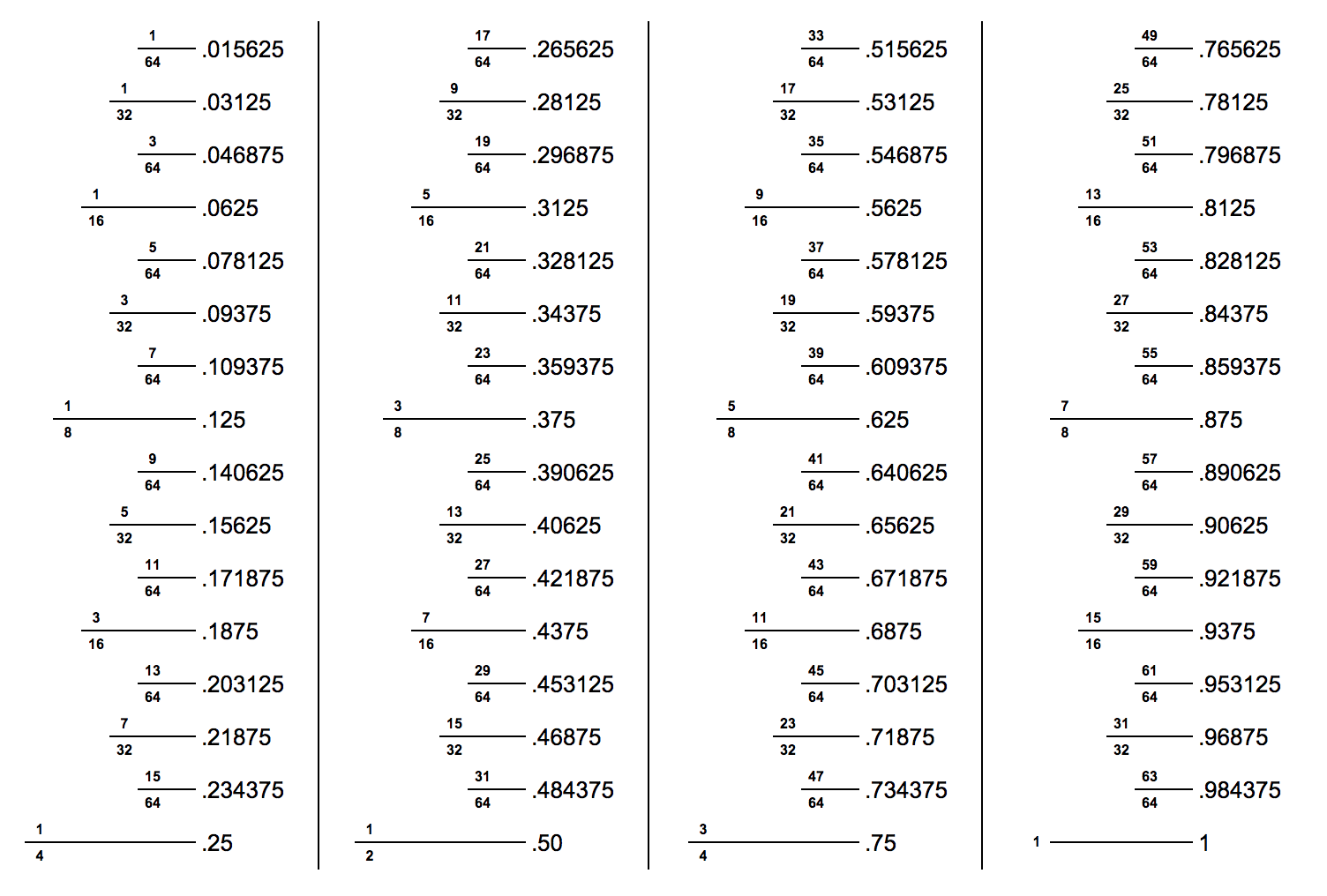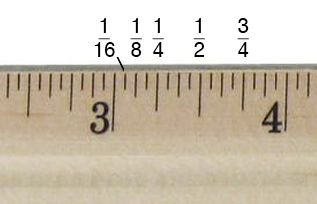Inch Fraction Calculator – Decimal to Inches
Convert inch fractions to decimal, decimal to inches, inches to metric measurements, metric measurements to inch fractions, and inches to feet using our inches to fraction calculator.
Inch Fraction, Decimal, and Metric Results
Imperial Units
Metric Units
On this page:
- Inch Fraction Calculator
- How to Calculate Inch Fractions
- How to Convert Inches to Fraction
- Decimal to Inches Chart
- How to Convert Inch Fractions to Decimal
- Inches to Decimal Chart
- How to Convert Inches to Metric Measurements
- How to Find Inch Fractions on a Tape Measure
- Frequently Asked Questions
- References
How to Calculate Inch Fractions
Measurements in inches can be expressed as a decimal or a fraction. When inches are expressed as a fraction, there are some special rules to follow, which are important to know to convert a decimal to inches correctly.
While fractions of an inch can be represented as any standard fraction, the most common fractions of an inch use denominators that are powers of 2, from half inches to up to the 64ths of an inch. That means the fraction denominators are most commonly 2, 4, 8, 16, 32, and 64.
These specific fractions of an inch are referred to as inch fractions.
As a result, if we want to convert a decimal to one of these inch fractions, then know that converting a decimal to an inch fraction is not quite the same as converting a decimal to a regular fraction.
Instead, some minor rounding will occur since it will be necessary to find the nearest fraction with the denominator that is a power of 2, also known as a dyadic fraction or dyadic rational number.[1] Typical inch fractions will look something like 1/64, 1/32, 1/16, 1/8, 1/4, or 1/2.
When you’re working with larger measurements, you can use our feet and inches calculator to add or subtract feet and inch fractions.
How to Convert Inches to Fraction
To convert decimal inches to an inch fraction, you’ll need to round the decimal portion to the nearest dyadic fractional inch.
First, separate the whole number from the decimal; these are the whole inches. Then, take the remaining portion of the decimal to the right of the decimal point and multiply it by the denominator of the level of precision you need (e.g., 1/16, 1/32, or 1/64).
For instance, to round to the nearest 1/16, take the decimal portion and multiply it by 16. Then, round the result to get the numerator of the inch fraction.
Finally, place the numerator over the level of precision, 16 in this case. Then, put the fractional inches next to the whole inches for the final result.
For example, let’s convert 2.695 inches to a fraction with 1/16″ precision.
Remove the whole number 2 from the decimal to leave us with the decimal 0.695.
Then, multiply 0.695 by 16.
0.695 × 16 = 11.12
Round this to the nearest whole number; in this case, 11.12 can be rounded to 11. Put that in a fraction over 16, so 11/16 is the remaining inch fraction.
Put it all together by placing the whole inches (2) in front of the inch fraction.
2.695 in ≈ 2 11/16
Thus, using this method, you can see that 2.695 decimal inches are approximately equal to 2 11/16 as an inch fraction. Note that we use an “approximately equal” sign instead of an equals sign because the two numbers are not exactly equal.
Decimal to Inches Chart
Use this decimal to inches chart to easily find the correct fraction for your decimal measurement or to convert inches to fraction. Find decimal equivalents in 1⁄64” increments, including 1⁄2“, 1⁄4“, 1⁄8“, 1⁄16“, and 1⁄32” measurements.
The chart also shows hints on the markings sizes found on a tape measure or ruler.

How to Convert Inch Fractions to Decimal
Converting an inch fraction to decimal inches is as easy as dividing the fraction. Divide the top number (numerator) by the bottom number (denominator) to find the value in inches as a decimal.
You can also use a fraction to decimal calculator or the chart below.
Inches to Decimal Chart
The inch fraction to decimal and metric chart below shows equivalent length measurements in fraction, decimal, and millimeters up to one inch in 1⁄64” increments. You can use this to convert inches to decimal or millimeters.
| Fraction (inches) |
Decimal (inches) |
Metric (millimeters) |
|---|---|---|
| 1/64″ | 0.015625″ | 0.396875 mm |
| 1/32″ | 0.03125″ | 0.79375 mm |
| 3/64″ | 0.046875″ | 1.190625 mm |
| 1/16″ | 0.0625″ | 1.5875 mm |
| 5/64″ | 0.078125″ | 1.984375 mm |
| 3/32″ | 0.09375″ | 2.38125 mm |
| 7/64″ | 0.109375″ | 2.778125 mm |
| 1/8″ | 0.125″ | 3.175 mm |
| 9/64″ | 0.140625″ | 3.571875 mm |
| 5/32″ | 0.15625″ | 3.96875 mm |
| 11/64″ | 0.171875″ | 4.365625 mm |
| 3/16″ | 0.1875″ | 4.7625 mm |
| 13/64″ | 0.203125″ | 5.159375 mm |
| 7/32″ | 0.21875″ | 5.55625 mm |
| 15/64″ | 0.234375″ | 5.953125 mm |
| 1/4″ | 0.25″ | 6.35 mm |
| 17/64″ | 0.265625″ | 6.746875 mm |
| 9/32″ | 0.28125″ | 7.14375 mm |
| 19/64″ | 0.296875 | 7.540625 mm |
| 5/16″ | 0.3125″ | 7.9375 mm |
| 21/64″ | 0.328125″ | 8.334375 mm |
| 11/32″ | 0.34375″ | 8.73125 mm |
| 23/64″ | 0.359375″ | 9.128125 mm |
| 3/8″ | 0.375″ | 9.525 mm |
| 25/64″ | 0.390625″ | 9.921875 mm |
| 13/32″ | 0.40625″ | 10.31875 mm |
| 27/64″ | 0.421875″ | 10.715625 mm |
| 7/16″ | 0.4375″ | 11.1125 mm |
| 29/64″ | 0.453125″ | 11.509375 mm |
| 15/32″ | 0.46875″ | 11.90625 mm |
| 31/64″ | 0.484375″ | 12.303125 mm |
| 1/2″ | 0.5″ | 12.7 mm |
| 33/64″ | 0.515625″ | 13.096875 mm |
| 17/32″ | 0.53125″ | 13.49375 mm |
| 35/64″ | 0.546875″ | 13.890625 mm |
| 9/16″ | 0.5625″ | 14.2875 mm |
| 37/64″ | 0.578125″ | 14.684375 mm |
| 19/32″ | 0.59375″ | 15.08125 mm |
| 39/64″ | 0.609375″ | 15.478125 mm |
| 5/8″ | 0.625″ | 15.875 mm |
| 41/64″ | 0.640625″ | 16.271875 mm |
| 21/32″ | 0.65625″ | 16.66875 mm |
| 43/64″ | 0.671875″ | 17.065625 mm |
| 11/16″ | 0.6875″ | 17.4625 mm |
| 45/64″ | 0.703125″ | 17.859375 mm |
| 23/32″ | 0.71875″ | 18.25625 mm |
| 47/64″ | 0.734375″ | 18.653125 mm |
| 3/4″ | 0.75″ | 19.05 mm |
| 49/64″ | 0.765625″ | 19.446875 mm |
| 25/32″ | 0.78125″ | 19.84375 mm |
| 51/64″ | 0.796875″ | 20.240625 mm |
| 13/16″ | 0.8125″ | 20.6375 mm |
| 53/64″ | 0.828125″ | 21.034375 mm |
| 27/32″ | 0.84375″ | 21.43125 mm |
| 55/64″ | 0.859375″ | 21.828125 mm |
| 7/8″ | 0.875″ | 22.225 mm |
| 57/64″ | 0.890625″ | 22.621875 mm |
| 29/32″ | 0.90625″ | 23.01875 mm |
| 59/64″ | 0.921875″ | 23.415625 mm |
| 15/16″ | 0.9375″ | 23.8125 mm |
| 61/64″ | 0.953125″ | 24.209375 mm |
| 31/32″ | 0.96875″ | 24.60625 mm |
| 63/64″ | 0.984375″ | 25.003125 mm |
| 1″ | 1.0″ | 25.4 mm |
How to Convert Inches to Metric Measurements
To convert inch fractions to metric measurements, you need to keep in mind that there are 2.54 centimeters or 25.4 millimeters per inch.
So, to convert an inch fraction to centimeters, you multiply the inches by 2.54, and to convert to millimeters, multiply by 25.4.
cm = in × 2.54
mm = in × 25.4
You can also use a length converter such as an SAE to metric converter.
How to Find Inch Fractions on a Tape Measure

Finding measurements on a ruler or tape measure can be confusing at first, but once you understand how the marks are laid out, then you’ll see it is quite simple. Notice that the markings between the whole-inch numbers vary in length.
The longest markings will be the quarter-inch markings, i.e., the first marking is 1/4 inch, the second is 1/2 (2/4) inch, and the third is 3/4 inch.
The next longest markings will be the eighth-inch markings, i.e., the first marking is 1/8 inch, the second is 3/8 inch, the third is 5/8 inch, etc.
The smallest markings will be the sixteenth-inch markings, i.e., the first marking is 1/16 inch, the second is 3/16 inch, the third is 5/16 inch, etc.

We also have a free printable ruler with fraction measurements marked to help you learn how to find the inch fractions for a measurement. If you need measurements more precise than 64ths of an inch, then you will need to use a more accurate measuring tool such as calipers.
Frequently Asked Questions
What is an inch fraction?
An inch fraction is a fraction of an inch with a denominator that is a power of two. For example, 1/2, 3/8, 15/16, 17/32, and 33/64 are all examples of inch fractions.
How big is one inch?
If you are more familiar with the metric system, one inch is equal to 25.4 millimeters or 2.54 centimeters. If not, a standard paperclip is one inch long, and the diameter of a U.S. quarter is also approximately one inch.
Do you use decimals or fractions for inches?
You can use either decimals or fractions when representing portions of an inch. Typically we use fractions when the portion of an inch equals one of the common inch fractions in the list above.
Why does the U.S. use inches?
The U.S. uses inches because it abides by the imperial system of measurements, whereas most of the rest of the world uses the metric system.
The United Kingdom adopted these imperial units in 1826, and since, at the time, it had much influence in the United States, the U.S. adopted them as well. Today, however, the United Kingdom has changed to primarily use the metric system.
What is the symbol for inches?
Inches are usually represented either with the abbreviation in, or with a double apostrophe, known as a double prime, ″. For example:
5 inches = 5 in = 5″
References
- The Free Dictionary, dyadic rational, https://encyclopedia2.thefreedictionary.com/Dyadic+rational+number


